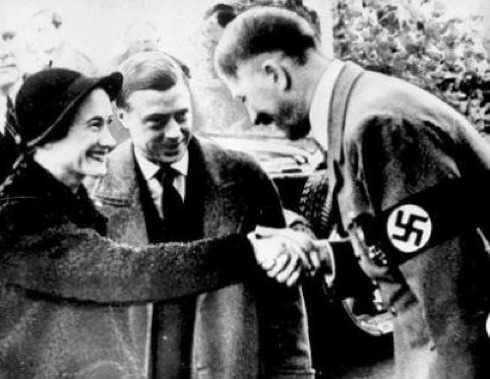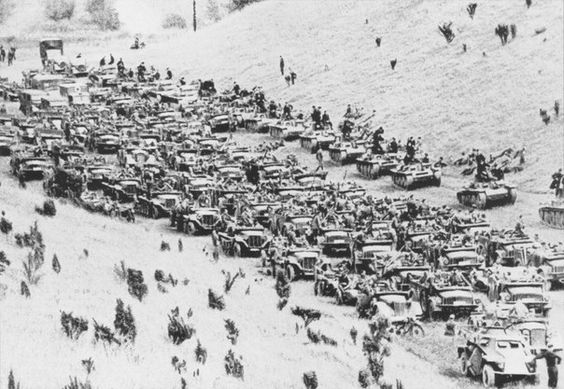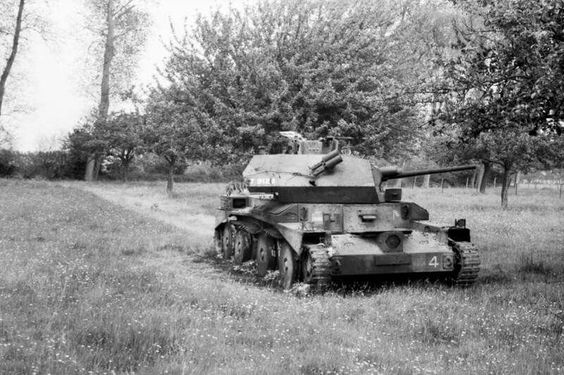Monday 5 May 1941
 |
| Emperor Haile Selassie during World War II. |
Other Luftwaffe targets during the night include Glasgow, Newcastle, North Shields and Cullercoats in Northumberland, Cleadon, Annfield Plain and Blaydon in Co Durham and Hull in Yorkshire.
The Luftwaffe "May Blitz" raids continue against Liverpool. Several more ships are damaged, some for the second time, including 6770-ton freighter Silversandal and 4672-ton freighter Clan Macinnes. In addition, 155-ton barge Traffic is sunk, and 231-ton whaler Sumba suffers a near miss and has to be beached before proceeding to Barry for repairs.
The Luftwaffe attacks several British ports and shipping in the English Channel during the day, causing widespread damage. In the Channel, they sink Royal Netherlands Navy trawler HNLMS Jean Frederic. There are 25 deaths.
The Luftwaffe also raids Lowestoft, sinking 147-ton Royal Navy boom defense vessel Fidelia.
In an attack on Greenock, the Luftwaffe heavily damages destroyer HMS Marksman as well as submarines Traveller and Trooper, which are under construction.
RAF Bomber Command sends 141 planes against Mannheim after dark.
 |
| A map of the situation in Iraq contained on page 6 of the 5 May 1941 New York Times. |
The British Defence Committee gives Middle East Commander General Archibald Wavell control over operations in Iraq. The Germans also have their eyes on Iraq and plan to supply it via their allies in Vichy Syria.
 |
| Emperor Haile Selassie during an address to the League of Nations. |
At Amba Alagi, the Indian troops (3/2nd Punjab Battalion) mount a pre-dawn raid across the exposed rock - the "Middle Position" - against entrenched Italian positions. In previous such situations, the Italians have proven adept at defending such positions with well-positioned machine guns, and this battle continues that pattern. The Indian troops are pinned down at barbed wire throughout the day and suffer 8 dead and 28 wounded, finally retreating after dark.
 |
| Haile Selassie enters Addis Ababa, 5 May 1941. |
British 436-ton freighter St. Eunan hits a mine five miles southwest of St. Ann's Head and is damaged. The St. Eunan makes it to port.
U-69 (Kptlt. Jost Metzler), the first Type VIIC U-boat, departs from Lorient for its first mission.
Two ships of the Royal Navy 1st Minelaying Squadron departs Loch Aish to lay minefield SN 9A, accompanied by four destroyers.
Royal Navy corvette HMS Begonia rescues 17 survivors of an unidentified merchant ship.
Convoy OG-61 departs from Liverpool bound for Gibraltar.
Royal Navy corvette HMS Mayflower is commissioned at Tyne, and corvettes HMCS Kamsack, Morden and Sherbrooke are commissioned in Canada.
Winston Churchill writes to Air Chief Marshal Sir Charles Portal that "I am most deeply concerned" at how the air war is developing in the Middle East:
If at the present time... we have a superiority [but] can only just hold our own, what will be our position in June, when... the enemy will have, or may have, nearly double our strength?He adds as an aside that "personally I never expected the Greek venture to succeed unless Turkey and Yugoslavia both came in."
Luftwaffe III Gruppe of JG 27 relocates to Sicily in order to prepare for the upcoming Operation Mercury, the invasion of Crete.
Part of Convoy WS 8A reaches Gibraltar from England. This is the Tiger Convoy which carries badly needed tanks for General Wavell in North Africa. The plan - a pet project of Winston Churchill - is to send this convoy directly through the Mediterranean, past German, Italian and Vichy French possessions.
The Royal Navy sends destroyers HMAS Voyager and Waterhen from Alexandria to Tobruk on a transport mission during the night. They immediately unload and head back within hours. This is the first supply mission to the port since the Germans invested it. This is the first of planned nightly supply missions.
The RAF (830 Squadron) lays mines in Tripoli Harbor. The pilots observe an Axis ship mysteriously blow up in the harbor while they are at work.
There is some trepidation in London (principally by Churchill) that the Germans may invade Cyprus instead of Crete. The Australian 7th Infantry Division (cavalry regiment) arrives there today.
Convoy WS 7X arrives in Bombay, India loaded with troops.
Bread rationing begins in Malta, but the price is reduced. It is a quiet day, with only one air raid alert that concerns planes that don't cross over the island. Convoy MW 7B departs Alexandria for Malta.
Spy Stuff: Tokyo suspects that its communications with the embassy in Washington, D.C. are being broken and read. It sends a message to this effect today to the embassy. An investigation is begun.
 |
| 14th Street and Ninth Avenue (northeast corner) on 5 May 1941 (Museum of the City of New York). Parts of this building survive unaltered near the Old Homestead Steakhouse. |
Churchill does require that, as a condition of this continuing US aid, the French permit no further Germans entry into French possessions in North Africa - a demand that will not be met and is more an attempt to save face than anything else. This agreement appears to be motivated as much to ingratiate Churchill with President Roosevelt as to help the French. Churchill rationalizes that the blockade has been ineffective anyway.
US/Australian Relations: After his meeting with the Prime Minister of Portugal on the 4th, Australian Prime Minister Robert Menzies departs from Lisbon aboard flying boat "Dixie Clipper" bound for Horta, the Azores. Menzies arrives safely. He is en route to Bermuda, and then New York.
Anglo/Irish Relations: Churchill writes in a memo to Herbert Morrison that "Northern Ireland does not appear to be making its utmost contribution to the war effort... one-eighth of the insured population is out of work." He requests that steps be considered to have Northern Ireland "display some initiative."
German/Romanian Relations: Marshal Ion Antonescu, who keeps a very close eye on Soviet troop movements, warns Hitler that the Soviets are massing troops around Kyiv and Odessa in what may be springboards for offensive action. In addition, Antonescu states:
The thing worth noting is that factories around Moscow have been ordered to transfer their equipment into the country’s interior.Hitler, of course, already is planning to invade the Soviet Union on 22 June 1941.
 |
| Hitler inspects the Kriegsmarine in Gotenhafen (Gdynia), apparently aboard the Bismarck, 5 May 1941. |
Soviet Government: Soviet Premier Joseph Stalin delivers two secret speeches to a Kremlin banquet held to honor a thousand graduating officers. All of the top Soviet brass, including Foreign Minister Molotov, Mikoyan, Voroshilov, Kalinin, and Lavrenti Beria, are there. The Germans later capture two attendees who independently recall that Stalin stated that the pact with the Third Reich was simply a temporary expedient. He states in his first speech:
New tank models, the Mark 1 and 3, are on their way; these are excellent tanks, whose armor can withstand 76-millimeter shells. In the near future there will also be a new tank graced with my own name. This tank will be a veritable fortress. Today we have up to a hundred armored and mechanized divisions which still need to be organized into an entity. Our war plan is ready, we have built the airfields and landing grounds, and the frontline aircraft are already there. Everything has been done by way of clearing out the rear areas: all the foreign elements have been removed. It follows that over the next two months we can begin the fight with Germany. Perhaps it surprises you that I tell you of our war plans. But we have to take our revenge for Bulgaria and Finland.Later, after much drinking by all, Stalin delivers a second speech. In this one, he states:
The slogan of peaceful policies is now obsolete—it has been overtaken by events. During the years of the capitalist encirclement of the Soviet Union we were able to make good use of the slogan while we expanded the Soviet Union’s frontiers to the north and west. But now we must discard this slogan for the reactionary and narrow-minded slogan that it is, as it will not serve to win us one more square inch of territory. It is time to stop chewing that particular cud, Comrade Chosin: stop being a simpleton! The era of forcible expansion has begun for the Soviet Union. The people must be schooled to accept that a war of aggression is inevitable; they must be in permanent mobilization.This aggressive stance will be hidden from the West, of course. It certainly does not justify in any way Germany's invasion of the Soviet Union. However, in hindsight, it serves as a countervailing argument to those who point to Hitler's Operation Barbarossa as an epic mistake.
British Government: First meeting of the Tank Parliament, a Cabinet Committee devoted to armored forces. Churchill has formed to "make a general examination of the present position and prospects of armored formations." The Tank Parliament will engage in long-range planning of equipment and strategy, and will, as today's minutes indicate, take into account that "we might have to reckon with a break eastwards by the Germans."
Venezuela: General Isaias Medina Angarita becomes president.
French Homefront: Coco Chanel comes up with a new strategy in her long-running campaign to gain control over perfumes issued in her name in the 1920s. She writes to the occupying German government - she lives in the Ritz with many top German officers - claiming proprietary ownership over company Parfums Chanel, and in particular its leading brand Chanel No. 5. It is another step in a long, complicated struggle by Coco to recover what she views as her rightful ownership over the perfumes.
Channel claims sole ownership of the company over Pierre and Paul Wertheimer, who are Jewish directors of perfume house Bourjois and control Parfums Chanel. Coco Chanel herself only has ten percent of the stock in their company, and basically just licenses her name to the Wertheimer brothers, but she long has felt that she deserves all of it for various murky reasons. Her past attempts have failed, but she decides to try again. The argument that Chanel makes (this time) is that the Wertheimer brothers, being Jewish, have abandoned the property (they sailed to New York in 1940). Coco writes:
I have, an indisputable right of priority ...the profits that I have received from my creations since the foundation of this business ...are disproportionate ...[and] you can help to repair in part the prejudices I have suffered in the course of these seventeen years.The Germans, of course, are not averse to helping out a fellow "Aryan" against some Jews who have fled (for very good reason). They discover, however, that the Wertheimer brothers have assigned their controlling rights in Parfums Chanel to a "front," Christian businessman and industrialist Felix Amiot. This tactic, fairly common during the Occupation, foils Coco's plan.
 |
| Coco Chanel with Adolf Hitler. |
Ultimately, the parties reach a settlement which makes Coco a very rich woman for a very unlikely reason: the brand depends in part on her image. The Wertheimer brothers reason that if it is revealed that Coco consorted with German officers during the Occupation, the entire business could be ruined. Basically, she extorts them by threatening to ruin herself. So, while they are on solid legal grounds in retaining ownership, they give Coco a generous portion of their profits essentially to keep her quiet and remain a positive image for the brand.
Thus, Coco Chanel's wartime "collaboration" (if it can be called that, and this is a very contentious issue) actually inures to her benefit in the long run. While there are scandalous rumors for the rest of her life, Coco Chanel's image remains intact until after her death in 1971 - at the Ritz.
 |
| The Front page of the 5 May 1941 NY Times. |
May 1941
May 1, 1941: British Hold Tobruk
May 2, 1941: Anglo-Iraq War
May 3, 1941: Liverpool Hammered
May 4, 1941: Hitler Victory Speech
May 5, 1941: Patriots Day
May 6, 1941: Stalin In Command
May 7, 1941: May Blitz
May 8, 1941: Pinguin Sunk
May 9, 1941: U-110 Captured
May 10, 1941: Hess Flies Into History
May 11, 1941: The Hess Peace Plan
May 12, 1941: Tiger Arrives Safely
May 13, 1941: Keitel's Illegal Order
May 14, 1941: Holocaust in Paris
May 15, 1941: Operation Brevity
May 16, 1941: Blitz Ends
May 17, 1941: Habbaniya Relieved
May 18, 1941: Croatia Partitioned
May 19, 1941: Bismarck at Sea
May 20, 1941: Invasion of Crete
May 21, 1941: Robin Moore Sinking
May 22, 1941: Royal Navy Destruction Off Crete
May 23, 1941: Crete Must Be Won
May 24, 1941: Bismarck Sinks Hood
May 25, 1941: Lütjens' Brilliant Maneuver
May 26, 1941: Bismarck Stopped
May 27, 1941: Bismarck Sunk
May 28, 1941: Crete Lost
May 29, 1941: Royal Navy Mauled Off Crete
May 30, 1941: Sorge Warns, Stalin Ignores
May 31, 1941: British Take Baghdad
2020












